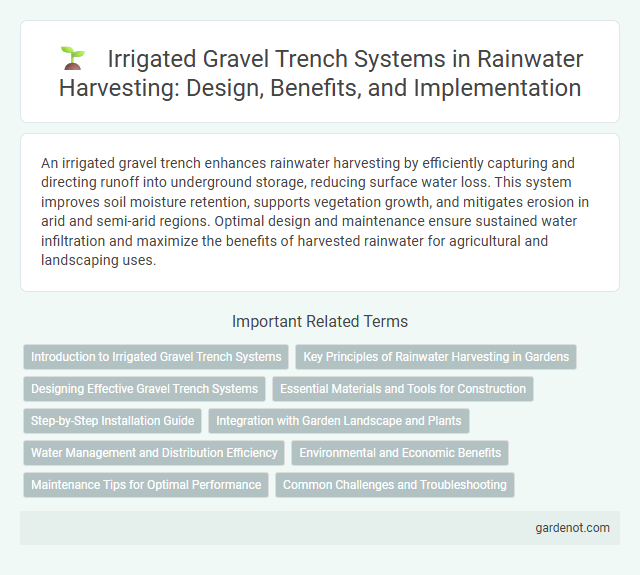An irrigated gravel trench enhances rainwater harvesting by efficiently capturing and directing runoff into underground storage, reducing surface water loss. This system improves soil moisture retention, supports vegetation growth, and mitigates erosion in arid and semi-arid regions. Optimal design and maintenance ensure sustained water infiltration and maximize the benefits of harvested rainwater for agricultural and landscaping uses.
Introduction to Irrigated Gravel Trench Systems
Irrigated gravel trench systems are an innovative rainwater harvesting method that enhances groundwater recharge and surface water management by combining infiltration and irrigation techniques. These systems utilize porous gravel trenches filled with coarse aggregates to capture and slowly release rainwater, reducing runoff and promoting soil moisture retention. Ideal for urban and agricultural applications, irrigated gravel trenches improve water efficiency while preventing erosion and supporting vegetation growth.
Key Principles of Rainwater Harvesting in Gardens
Irrigated gravel trenches enhance rainwater harvesting by promoting efficient infiltration and storage of runoff in garden beds, reducing surface runoff and soil erosion. These trenches utilize permeable gravel layers combined with irrigation systems to maintain optimal moisture levels for plant root zones, supporting sustainable water use. Incorporating irrigated gravel trenches aligns with key principles of rainwater harvesting by maximizing on-site water retention and improving groundwater recharge in landscaped areas.
Designing Effective Gravel Trench Systems
Designing effective irrigated gravel trench systems requires careful consideration of trench depth, width, and gravel size to maximize water infiltration and storage capacity in rainwater harvesting applications. Proper slope and layering techniques ensure uniform water distribution and prevent clogging, enhancing the efficiency of groundwater recharge. Selecting durable materials and incorporating filtration layers further improves system longevity and sediment control.
Essential Materials and Tools for Construction
Essential materials for constructing an irrigated gravel trench include high-quality gravel with proper drainage properties, geotextile fabric to prevent soil clogging, and perforated PVC pipes for effective water distribution. Tools required encompass a shovel or excavator for trench digging, a level for ensuring proper slope, and a compactor to stabilize the gravel base. Proper selection and use of these materials and tools ensure efficient rainwater capture and soil infiltration.
Step-by-Step Installation Guide
Begin by excavating a trench approximately 12-18 inches wide and 18-24 inches deep, ensuring a slight slope for drainage. Line the trench with landscape fabric to prevent soil infiltration, then fill it with clean, washed gravel or crushed stone up to ground level. Install a perforated pipe within the gravel, connect it to the rainwater collection system, and cover the trench with more gravel before topping it with soil or mulch to promote water infiltration and prevent runoff.
Integration with Garden Landscape and Plants
Irrigated gravel trenches enhance rainwater harvesting by seamlessly integrating with garden landscapes, promoting efficient water infiltration and soil moisture retention. This system supports plant health by delivering consistent hydration to roots while preventing surface runoff and erosion. Incorporating native and drought-tolerant plants around the trenches maximizes water conservation and complements sustainable garden design.
Water Management and Distribution Efficiency
Irrigated gravel trenches enhance rainwater harvesting by improving water infiltration and storage within soil profiles, promoting efficient moisture retention. Their design maximizes water distribution uniformity, reducing runoff and evaporation losses while supporting plant root zones effectively. Implementing these trenches optimizes groundwater recharge and sustains irrigation demands with minimal water waste.
Environmental and Economic Benefits
Irrigated gravel trenches significantly improve rainwater infiltration, reducing surface runoff and soil erosion while enhancing groundwater recharge. This sustainable water management practice lowers irrigation costs by decreasing reliance on municipal water supplies and promotes healthier plant growth through consistent soil moisture levels. Implementing irrigated gravel trenches can lead to long-term economic savings and contribute to environmental conservation by maintaining local hydrological cycles.
Maintenance Tips for Optimal Performance
Regularly inspect the irrigated gravel trench for sediment buildup and remove debris to maintain efficient water flow and prevent clogging. Periodically flush the system with clean water to dislodge accumulated particles and preserve infiltration capacity. Ensure vegetation near the trench is controlled to avoid root intrusion that can disrupt the gravel's permeability and hinder rainwater harvesting effectiveness.
Common Challenges and Troubleshooting
Irrigated gravel trenches in rainwater harvesting systems commonly face challenges such as clogging due to sediment accumulation and uneven water distribution. Regular maintenance including flushing and sediment removal is essential to prevent blockages and ensure optimal infiltration rates. Addressing issues like soil compaction around the trench improves permeability and overall system efficiency.
Irrigated gravel trench Infographic

 gardenot.com
gardenot.com